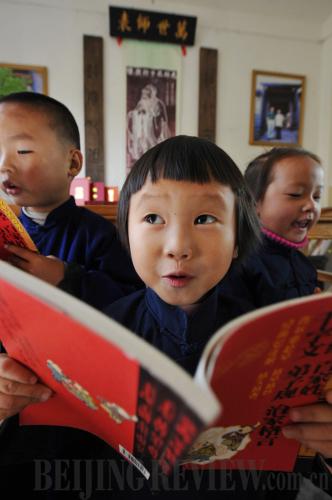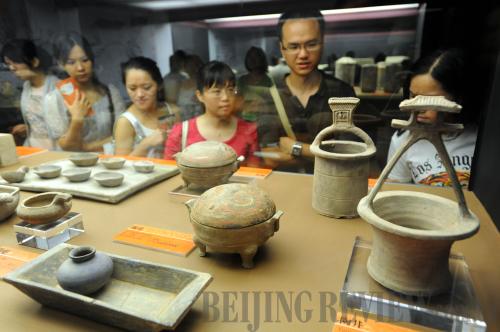|
 |
|
FEVER OF TRADITIONAL CULTURE: Children at a primary school in Guizhou Province read classic Chinese books in class (ZHANG LEI) |
 |
|
COMMUNICATION WITH RELICS: Taiwan people visit an exhibition of relics of Han Dynasty (202 B.C.-A.D. 220) jointly held in Taipei by cultural institutes of both the mainland and Taiwan (WU JINGTENG) |
Anniversary Celebration
The year 2009 marked the 60th anniversary of the founding of the People's Republic of China. More than 100 outstanding TV shows, hundreds of significant books, music and dance works were produced for the celebration. The musical dance epic Road to Revival bloomed for the first time during the anniversary, and attracted a great audience.
A New Popular Star and His Art Form
At national TV broadcaster CCTV's 2009 Spring Festival Gala, Shen Chunyang, known as Little Shenyang, made a name for himself after performing in the comic sketch Money Is Not A Problem. His performance took some jokes and performing styles from Errenzhuan, a northeastern art form, which involves story telling, singing and dancing between two performers, and is considered a grassroots form of entertainment. Shen has risen quickly to become a very popular star and Errenzhuan has also became more popular. Shen's master, Zhao Benshan, renowned as the "King of Comedy" in China, opened a theater at downtown Beijing specially for Errenzhuan performance. Shen and some other Errenzhuan performers also starred the movie A Simple Noodle Story debuted on December 10, 2009, the latest work of Zhang Yimou, Director of the opening ceremony of 2008 Beijing Olympic Games, bringing the popularity of this northeastern folk art to another peak.
Lost Relics
The auction on February 25, 2009, of two bronze sculptures at Christie's Paris aroused condemnation from the Chinese Government and the public. The two sculptures, which were looted by invading Anglo-French expedition army in the Second Opium War in the 19th century, were bid for by Cai Mingchao at the February auction. However, he refused to pay the $39.63 million wanted. The State Administration of Cultural Heritage of China said the auction "damaged Chinese citizens' cultural rights and feelings and will have serious effects on Christie's development in China," the Xinhua News Agency reported. In recent years, Beijing has made great efforts to seek the return of lost cultural relics by every method in line with diplomacy, laws and cooperation, and encouraged overseas organizations and collectors to donate relics back. Because of these actions, nine ancient bronze vessels were given back to China. In late 2009, a team of China's cultural experts traveled to museums throughout the United States in search of the lost items.
More Heritage On the List
On June 26, 2009, Wutai Mountain in north China's Shanxi Province was included in the World Culture Heritage List, bringing the number of China's world heritage listings to 38. From September 28 to October 2, 2009, 22 items were all included on the world's intangible cultural heritage list, which included the Dragon Boat Festival, Chinese calligraphy, stone carving, paper-cutting and Tibetan Opera. The embroidery of Qiang and Li ethnic groups was included in the List of Intangible Cultural Heritage in Need of Urgent Safeguards. The number of intangible cultural heritage listings of China reached 29, making China the country in the world with the highest number.
More Support for the Cultural Industry
On July 22, a plan to promote the country's cultural industry, which encourages private and foreign capital flow, was adopted by a meeting of the State Council of China. The plan sets eight key work areas to develop the industry. On September 27, the plan was officially promulgated. This is the first plan focused on developing the cultural industry, which has thus become one of China's strategic industries. It sends out the message that the Central Government will lend both policy and financial support to the growth of the cultural sector.
Traditional Culture in Vogue
Yi Zhongtian, a famous lecturer with CCTV's Lecture Room flew around the Chinese mainland to take part in various shows and gave lectures on Chinese literary classics, attracting tens of millions of viewers. His books were also one of the best sellers. At the same time, Yuan Tengfei, another scholar made his name known for teaching history to the public in an innovative way, which is quite different from the traditional way of telling history in China. His lectures presented by Lecture Room attracted a more than 1 million strong audience. It was in 2009 when the Chinese public focused much more of their enthusiasm on Chinese traditional culture. During the year, the market for Chinese culture studies rose rapidly. Training institutions, mass media, corporations and different level of governments participated in the sharing of benefits from the boom era.
China at Book Fair
As the guest of honor at the Frankfurt Book Fair 2009, China aroused great interest in Chinese culture and literature in Germany. The book fair lasted for six days and the area for Chinese exhibition attracted a great number of visitors who experienced a strong Chinese cultural flavor via modern visual art forms. The four forums held by China during the book fair were also highlights. The growth in China's publishing industry despite the financial crisis drew great attention from its foreign counterparts during a summit on the economy at the fair. Several Chinese writers also promoted their latest works that covered various themes. Readers took the opportunity to hear about the latest developments in Chinese literature as well as the reading habits and aesthetic tastes of contemporary Chinese readers. Some 270 publishers and over 2,000 book traders from China participated in the fair, setting a new record.
Good Quantity of Home-Made Movies
With production and box office surpassing any previous year, 2009 was a fruitful year for China's film industry. The 60th anniversary of the founding of the New China gave the industry a boost. More than 400 domestic movies were produced in 2009 and the total box office of domestic films in 2009 exceeded 6 billion yuan ($882 million), an increase of 40 percent compared to that in 2008. The production scale of the movies, their market and the investment all expanded as well. But although the market was prosperous, it has been a consensus that the quality of the movies were still not so good. Most of the movies employed big stars or computer technology to create a buzz. The epic film The Founding of a Republic contained more than 70 super stars and was a huge success at the box office.
Exhibitions Enhance Cross-Straits Communication
On February 14, 2009, a delegation from the Palace Museum in Taipei visited the Palace Museum in Beijing to discuss the cooperation of the two museums on holding exhibitions. A historic exhibition about the Emperor Yongzheng (1678-1735) of the Qing Dynasty (1644-1911), was held in Taipei from October 7, 2009 to January 10, 2010. It created a sensation with more than 700,000 visitors. The Taipei Palace Museum expressed the hope that it would also cooperate with the Beijing Palace Museum in 2010 to hold an exhibition about another distinguished Qing Dynasty emperor, Emperor Kangxi (1654-1722). Meanwhile, on November 10, 2009, an exhibition drawn from famous cultural relics collectors from both the mainland and Taiwan ran for 20 days in Beijing. With more than 70 very rare and precious items, the exhibition was the biggest and highest-level of its kind.
Tomb Discovery
The Administration of Cultural Heritage of central China's Henan Province announced on December 27, 2009 that they had discovered the tomb of Cao Cao (155-220), a renowned warlord and important politician in China's history, in Anyang County of the province.
More than 250 pieces of relics were unearthed from the 740-square-meter tomb, a size appropriate for a king, the administration said. Archaeologists also found 59 stone steles engraved with the descriptions and the number of articles buried in the tomb. Also unearthed were a large number of paintings on stone tablets.
The announcement soon sparked a debate in society about the authenticity of the evidence the administration presented. After several days of research and study, an expert team of the Institute of Archaeology of the Chinese Academy of Social Sciences (CASS) later announced that based on current archaeological research, the unearthed ancient tomb in Anyang could be "primarily ascertained" to be Cao's. At the same time, CASS added the discovery of Cao's tomb to the list of China's six major archaeological findings in 2009.
Compiled by Yuan Yuan |
